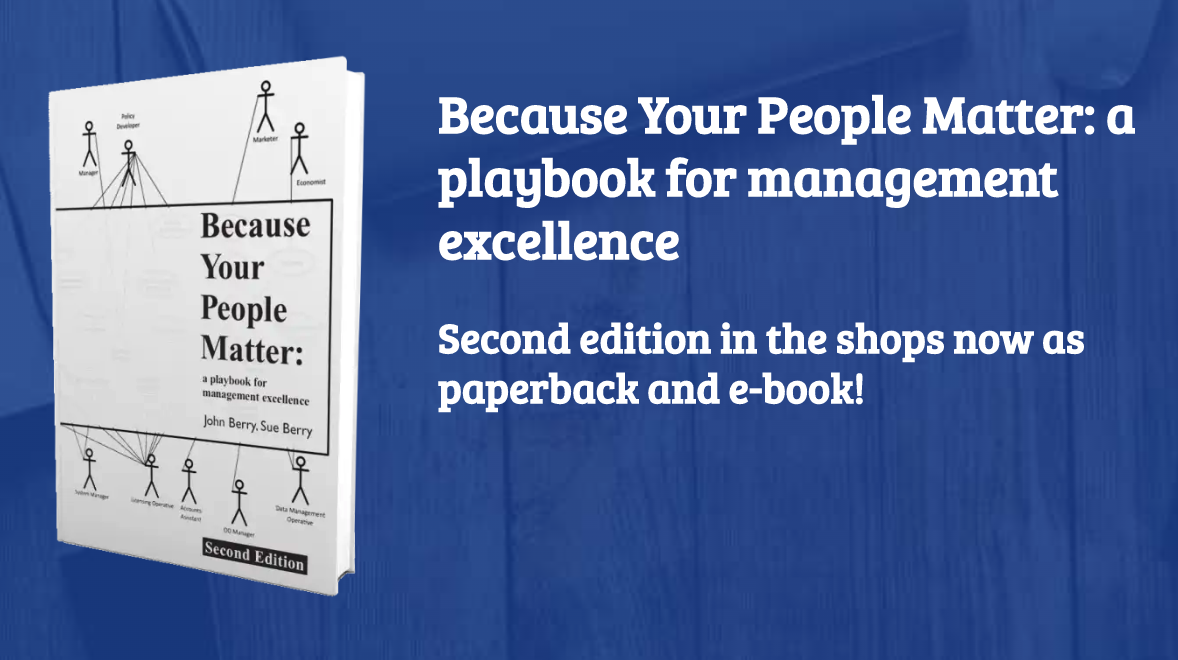One of several papers on recruitment and selection
Mixing internal and external candidates devastates staff commitment
Written by John Berry on 25th September 2017. Revised 17th June 2022.
7 min read
 Sometimes managers are crass.
Sometimes managers are crass.
Imagine taking deliberate management action that would damage the feelings, beliefs and attitudes that a significant number of your people have towards you and the firm? If you knew how bad the outcomes would be, would you take the actions?
We’d hope not.
And yet many managers deliberately mix internal and external recruitment in the hope of selecting the best person for the job from as large a pool as possible. It’s just wrong, damaging and here’s why.
Affective commitment
Affective or emotional commitment to the firm is the ultimate Holy Grail for managers. If a person actually wants to come in to work, half the battle is won. A host of other management interventions become possible. Conversely, of course, if they don’t want to come in, management becomes difficult. The emphasis is on ‘want’.
And if those feelings, beliefs and attitudes become quite negative and merge with other negatives, intention to quit (the firm) is heightened.
Affective commitment is in the mind of the employee and is won by the manager. There are many mechanisms, of which exchange is central[1]. Respect and trust follow.
Affective commitment takes time to build.
Affective commitment is also destroyed quickly by simple actions. Sometimes it’s not injustice that directly affects the employee – it’s actions they observe. Sometimes it’s their perception, rather than direct action on the employee. Either way, affective commitment is built slowly and destroyed in an instant. It’s valuable but fragile.
Vacancies
When re-organising or filling new roles, managers understandably want to fill the posts with the best person for the job. Logically this is the right thing to do. Until, that is, we consider that a firm is a social organism and existing staff have feelings, beliefs and attitudes that are influenced by management action.
Let’s look at what happens when management elect there’s a juicy new role that it considers that, say, five internal people might like to be considered for.
Those five are approached by their respective managers and encouraged to apply. They now all feel valued. Management think they are good – that’s apparent – and that they could be good enough for the new role. Their commitment has risen. They’ve been given an opportunity and they will respond with a good application.
Internal candidate effort
Typically those five will each spend 20 hours on that application – more if the interviews involve presentations and work on plans and strategies. For a senior role it could amount to 60 hours – and with that goes a huge emotional engagement with the task. In the vernacular, they’re psyching themselves up to face the selection process.
Of course, each will have heard, and maybe been told, that there are four colleagues in the running. They’ll each have views on their colleagues’ chances but in the end, and provided that the colleagues are competent, they’ll not mind loosing in a fair fight. The competition only encourages and emboldens them.
Now there’re up for it. Bring on the interviews.
Mixing internals and externals
The problem is this.
Fundamentally, in suggesting that the five internal candidates apply, management must have thought that any one of them could do the job. Otherwise, why suggest that internals apply.
Now here's the crass bit. Let’s assume that management seeks to widen the field and get 10 CVs from agencies. By expanding the field to include 10 externals, management believes they’ll get an even better result; that they’ll find someone who is better than the internals.
By pitching internals against externals, management is setting itself up to fail.
The source of this problem is in using a relative and variable measure to predict who will perform in the job, rather than an absolute one.
Relative or absolute
The activity of selection aims to predict which of the candidates will excel when in the job. Management can set an absolute or fixed bar – ‘anyone over this standard will excel’. Or it can set a relative or variable bar – ‘we will score all candidates for their ability to excel and chose the person who ranks first’.
 When recruiting all from internals, or all from externals, the relative ranking makes sense. But when mixing, it creates problems.
When recruiting all from internals, or all from externals, the relative ranking makes sense. But when mixing, it creates problems.
Management knows much about internals. Each comes with ‘baggage’. Managers remember a lot about them. And yet little is known about externals, save for their CV.
Psychology theory tells us how, depending on the information we find, we make biased positive assumptions[2]. It explains how someone from the BBC, for example, can be assumed to have high journalistic competence compared to someone who has worked freelance. There’s often no evidence for that claim, but we fill in the gaps with positive assumptions. So externals are extended the ‘benefit of the doubt’ by management.
In a relative, ranked system, internals are dammed and externals float to the top.
Commitment damage
And now the outcome.
For sure, the external person who wins the contest is elated. They have a new job and can’t wait to get started. They’re now working their notice at their existing firm. So there’s one person happy.
Of the five internal candidates, one will be spitting. He or she put so much in. They were encouraged to strive by their manager – they were sent a strong message that they were good enough. They have decided that with this, and maybe with other issues, they’ve lost confidence in management – their trust in management is destroyed.
Perhaps they’re thinking, “If ‘they’ can behave like this now, how’s it going to be next time? I’m just not going to get anywhere.”
They have decided to quit. Maybe not right now, but when they’re ready.
Three others are thinking, “It’s hopeless.” Their affective commitment is rock bottom but they have to stay – they need the money or are obligated. Don’t expect much growth and high performance from them – they’re lost.
And the remaining one will be plotting his or her revenge.
But it doesn’t stop there. Those five talk. Their colleagues will want to know how the process went. Colleagues will sympathise. Maybe as many as 30 others will be wary of management, thinking, “If that’s the way it goes here, I’d best not be thinking I can rely on a promotion, so I’ll broaden my plans”.
Overall we have one happy external person and 35 internals with varying degrees of damage to their affective commitment.
Oh dear! Was that what management intended?
Pity the external hire as they join the now-unhappy band. How long will they last?
Doing it right
So what should be done?
Simply, consider internals first, in isolation. If any internal can do the job – judged by a fixed bar - they go forward to an internals-only contest. Because any one is judged as having the ability to excel, a variable bar selection can be used to rank them.
Before encouraging internals to apply, management must sincerely believe that one or more of them will excel. If one or more internals are judged above the fixed bar, one must be selected from the internal pool.
Of course, there’s nothing wrong with putting the vacancy on a notice board – but management must not encourage internals to apply.
If there are no internals who clear the bar, then, and only then, should management seek external applicants.
Simply, don't mix internal and external recruitment.
- 'Exchange' is key to building affective commitment. Under this, the manager gives valuable concessions to the employee – like flexibility and training. The employee is indebted and responds with improved commitment.
- The Gestalt 'law of good continuance' encourages us to 'join the dots' or fill in missing data assuming that this missing data supports the data that is expressed (in the CV, for example). And the 'halo effect' suggests that positive information available bleeds over to encourage positive assumptions about other traits on which there is no information. Finally, the 'primacy effect' encourages interviewers to focus, when finally they meet, on positive attributes of external candidates discovered early in the recruitment process.